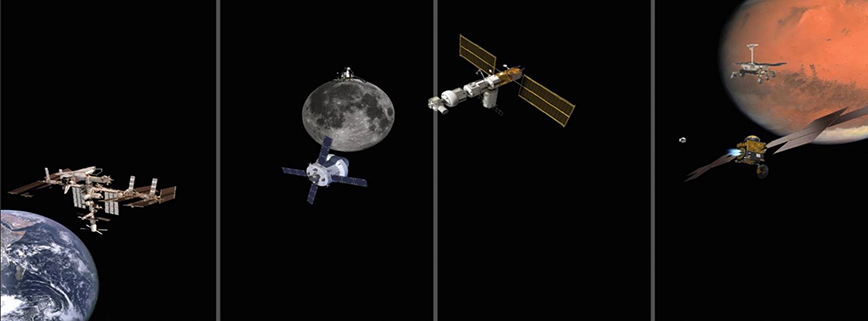
The ESA Exploration Programme (European Exploration Envelope Programme - E3P) targets four destinations: Low Earth Orbit (LEO), Beyond LEO, Moon and Mars. Furthermore, E3P has two transversal components: ExPeRT (Exploration Preparation, Research and Technology) and SciSpacE (Science in Space Environment).
LEO comprises the contributions from ESA to the International Space Station (ISS).
For more information... ![]()
Beyond LEO comprises the European contributions to the ARTEMIS programme of NASA ![]() , i.e. the European Service Modules for the American Orion Module (NASA's next generation human capsule), as well as two major contributions to the Gateway:
, i.e. the European Service Modules for the American Orion Module (NASA's next generation human capsule), as well as two major contributions to the Gateway:
The third destination is the Moon and current activities are mainly focused on cooperating with Russia in their Luna missions (comprising of two landers and one orbiter) and with the goal to study the composition of the soil near the lunar south pole. ESA's contribution is focussed on a camera landing system 'PILOT' as well as a drill and a miniature laboratory. More information... ![]()
Furthermore, ESA is studying the European Large Logistics Lander (EL3) concept, which would be a European lunar cargo landing capability based on the Ariane 64 rocket and the ATV heritage. EL3 would allow for two kind of missions: Scientifically-driven missions such as returning well-preserved and well-characterised samples from unexplored and inaccessible lunar regions, and missions delivering cargo to support human missions on NASA’s ARTEMIS programme. In order to fit into the plans of ESA's international partners EL3 should be ready by 2027.
The fourth destination of the E3P programme is Mars. ESA is currently implementing the ExoMars mission, which is a collaboration with Russia where Russia provides the two rockets that are needed for this two-stage mission, as well as the landing platform of the second mission. The first ExoMars launch was in 2016 and brought the Trace Gas Orbiter to Mars as well as the entry, descent and landing demonstrator module (also known as Schiaparelli). The former provides a relay for communication with Earth as well as scientific instruments (including the Belgian instrument 'NOMAD' ![]() ) to detect and study atmospheric trace gases, such as methane, the latter contained sensors to evaluate the lander’s performance as it descended, and additional sensors that would study the environment at the landing site.
) to detect and study atmospheric trace gases, such as methane, the latter contained sensors to evaluate the lander’s performance as it descended, and additional sensors that would study the environment at the landing site.

The second stage of the mission will be launched in 2022 and will will deliver a European rover, called Rosalind Franklin, and a Russian surface platform, Kazachok, to the surface of Mars.
The first Belgian instrument to land on Mars, Lander Radio science (LaRa), will be located on the Russian platform and will study the internal structure of Mars. The rover will carry a drill and a suite of instruments dedicated to the search for signs of life on Mars and geochemistry research.
ExoMars will be the first mission to combine the capability to move across the surface and to study Mars at depth.
The next Mars Mission, 'Mars Sample Return' is already under preparation in cooperation with NASA and will bring Martian soil to Earth.
The transversal E3P pilar ‘ExPeRT’ manages the development of studies and technologies for future Exploration missions to low Earth orbit, Moon and Mars destinations, while ‘SciSpacE’ is dedicated to science conducted in facilities in space (sounding rockets, ISS…) or facilities mimicking (aspects from) space such as drop towers, parabolic flights…
The latest information about the research announcements ![]() .
.
Scientists may be eligible to apply for different types of financial support through the Prodex Programme; for more details see the Belgian Guidelines for the ESA PRODEX Programme.
Within the E3P framework, ESA Member States participating to E3P may also offer national payloads to be flown on the ISS.
More information about these national payloads ![]() .
.
Tom Verbeke
Space Research & Applications